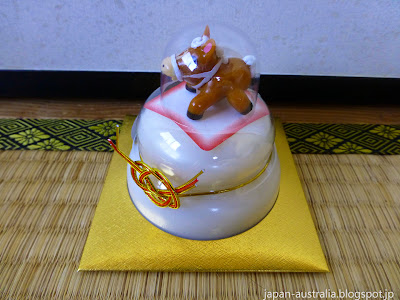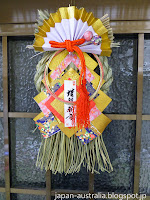New Year’s or
oshogatsu (正月) in Japanese is one of the most important holidays on the calendar in Japan. It is a time to look back to the past and follow the traditional customs of the festive season. Most people will return home to spend the time together with their families, kind of like Christmas in the West. It is also a popular tradition to visit a temple or shrine at midnight on December 31st, as Buddhist temples all around Japan ring their bells a total of 108 times to symbolize the 108 human sins in Buddhist belief and to get rid of the 108 worldly desires.
January 1st or New Year’s Day is a very fortunate day in Japan. It is meant to be full of joy and happiness with no stress or anxiety. Everything should be clean and you should not work on this day. A popular custom is to watch the first sunrise of the New Year (初日), which is meant to guarantee good luck for the New Year. It is tradition to visit a shrine or temple during
oshogatsu for
hatsumode, the first visit of the New Year. The bigger more popular shrines and temples are extremely crowded with people praying for health and happiness. We usually visit Inaba Jinja, which is the most famous shrine in Gifu City.
Here are some traditions and customs that are followed during New Year’s in Japan
Shimekazari
Shimekazari (しめ飾り) is a traditional New Year’s decoration made out of sacred Shinto rice straw rope, pine twigs, and carefully crafted zigzag-shaped paper strips called
shide.
Shimekazari is usually hung on the front door, and is used to keep bad spirits away as well as inviting the
toshigami (歳神) or Shinto deity to visit. Unlike Christmas decorations which are usually packed up and used the following year, New Year's decorations must be new as they symbolize a brand new start and a move away from the past. It is good luck to hang up the
shimekazari straight after Christmas, but no longer than after the 28th of December. It is custom to remove the
shimekazari on either January 7th or after the 15th, depending on which area of Japan you live.
 |
| Shimekazari |
Kagami Mochi
Kagami Mochi (鏡餅) is another traditional decoration that consists of two round
mochi (rice cakes). The smaller rice cake is placed on top of the larger one with a
daidai (bitter orange) on top. The two
mochi represent the past year and the year ahead with the
daidai, which means “generations” in Japanese representing the continuation of a family from one generation to the next. These days you can buy a modern version with the zodiac sign for the coming year on top instead of the bitter orange. 2014 was the year of the horse, with 2015 being the year of the sheep.
 |
| Kagami Mochi |
Mochibana
Mochibana (餅花) is a popular New Year’s decoration that consists of branches decorated with pieces of white and pink
mochi. They look like flowering branches of the blossoms in spring, and signal the coming of spring ahead in Japan.
Nengajo
Nengajo (年賀状) is a Japanese custom of sending a New Year’s Day Card to friends and relatives. It is very similar to our custom of sending Christmas Cards. Japanese people send these so that they arrive on January 1st. It is common to feature the zodiac sign for the coming year on the card.
Toshikoshi Soba
Toshikoshi Soba (年越しそば) is buckwheat noodles that are eaten on New Year’s Eve and symbolise longevity. It is believed that by eating these long thin noodles you will live a long and healthy life.
Toshikoshi means the ending of the old year, and the beginning of the new one. It has become a modern tradition to eat
toshikoshi soba while watching TV on New Year’s Eve, with the music competition Kohaku Uta Gassen (紅白歌合戦) the most popular show. To ensure good luck, all the noodles must be polished off before midnight.
 |
| Toshikoshi Soba |
Hatsumode
Hatsumode (初詣) is the first shrine visit of the New Year to pray for health, happiness and prosperity for the coming year. Most people will make their visit on the first, second, or third day of the year. A common custom is to buy an
omikuji, which is a fortune written on a small piece of paper. If the
omikuji predicts bad luck, you can tie it onto a tree on the shrine grounds, in order for the prediction not to come true.
 |
| Hatsumode at Inaba Jinja in Gifu City |
Osechi Ryori
Osechi Ryori (御節料理) is traditional Japanese dishes served during New Year celebrations. The tradition started in the Heian Period (794-1185) with each dish having a special meaning.
Osechi ryori is served in special boxes called
jubako (重箱) and contain food such as
konbu (boiled seaweed),
kamaboko (fish cakes),
kinpira gobo (burdock root), and
kuromame (sweetened black beans).
 |
| Osechi Ryori |
Ozoni
Ozoni (お雑煮) is a soup made with
mochi (rice cakes) traditionally served on New Year’s Day. Our family usually has
ozoni for breakfast on New Year’s Day.
Ozoni varies from region to region and from household to household.
 |
| Ozoni |
Otoshidama
Otoshidama (お年玉) is special money given to children on New Year’s Day. It is handed out in small decorated envelopes by family and relatives. The amount varies depending on the age of the child, but typically will be either ¥5,000 (USD$50) or ¥10,000 (USD$100).
Mochi
Mochi (餅) a favourite custom is creating mochi or soft rice cakes from boiled sticky rice. This is called
mochitsuki (餅つき) and is usually made before New Year’s Day and eaten during the start of New Year’s in January.
Hope you have a great New Year's wherever you are in the world!
 |
| Kadomatsu |
























































